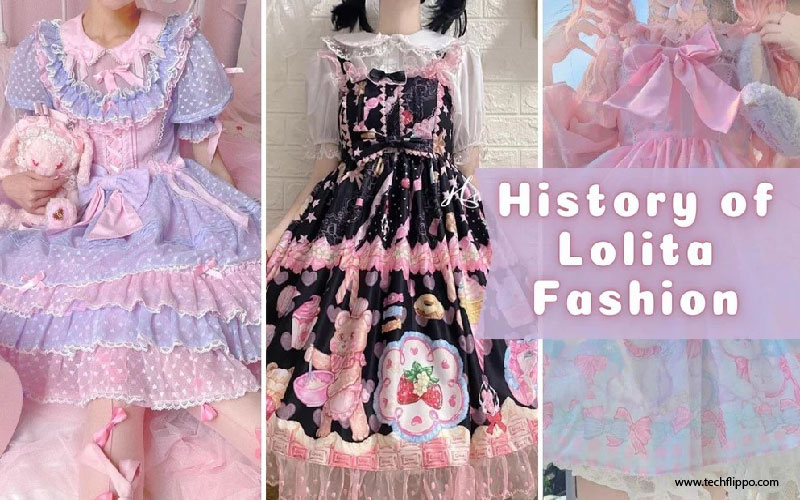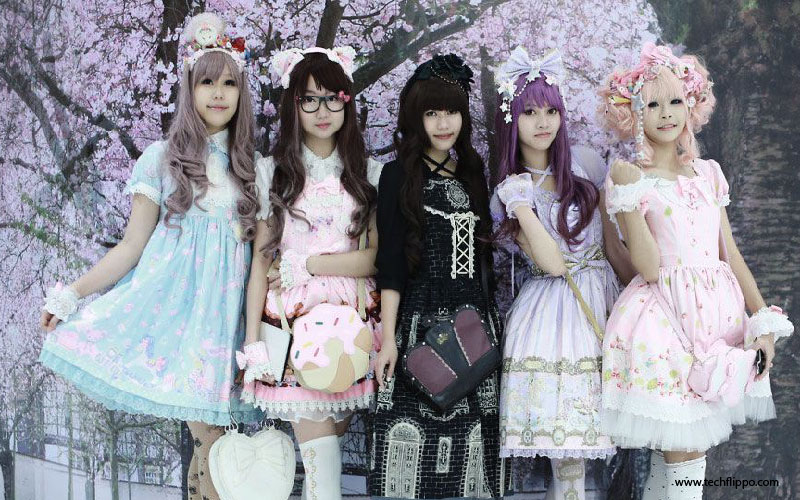The Evolution of Lolita Fashion Trends
Lolita fashion is more than just a style; it’s a captivating blend of art, culture, and personal expression. Rooted in the Victorian and Rococo eras, this unique aesthetic has evolved over decades to become a global phenomenon. From its delicate lace and intricate patterns to the vibrant subcultures that surround it, Lolita fashion continues to intrigue enthusiasts worldwide. As we delve into the evolution of Lolita trends, you’ll discover how this enchanting style has transformed lives and challenged norms while creating a rich tapestry of beauty and self-identity. Buckle up as we take you on a journey through time!

The History of Lolita Fashion
Lolita fashion emerged in Japan during the 1980s, rooted in the country’s punk and goth movements. It quickly transformed into a distinctive style that celebrates Victorian and Rococo aesthetics.
The term “Lolita” derives from Vladimir Nabokov’s novel but has been redefined within this cultural context. Early adopters sought to challenge societal norms by embracing an innocent yet elaborate look.
Key figures like designer Junko Koshino played pivotal roles in popularizing these trends. The Lolita subculture gained momentum through magazines, local events, and street fashion scenes.
As it evolved throughout the 1990s, online communities began to flourish. They created safe spaces for enthusiasts to share inspiration, outfits, and ideas about their beloved style.
This history reflects an ongoing dialogue between tradition and modernity. Each generation adds its twist while staying true to core aesthetic principles.
Types of Lolita Styles
Lolita fashion boasts a variety of styles, each with its own charm and distinct characteristics. One popular type is Sweet Lolita, known for its pastel colors, playful motifs, and candy-themed accessories. This style often embraces frills and bows, creating an innocent yet whimsical look.
On the other end of the spectrum lies Gothic Lolita. It leans towards darker color palettes like black and deep red. Elegant lace details and Victorian-inspired silhouettes give it a mysterious allure that captivates many enthusiasts.
Classic Lolita melds vintage inspiration with contemporary fashion elements. Rich fabrics and muted tones define this sophisticated style while maintaining an air of timelessness.
There’s Punk Lolita which introduces edgy aesthetics to traditional looks. Studded accents, bold patterns, and contrasting layers make this substyle stand out in vibrant ways that challenge norms within the community. Each variation offers endless possibilities for self-expression through clothing choices.
Influences on Lolita Fashion Trends
Lolita fashion is a rich tapestry woven from various influences. Its roots can be traced back to Victorian and Rococo aesthetics, which celebrate opulence and femininity. The intricate lace, voluminous skirts, and delicate fabrics draw heavily from these historical styles.
Japanese pop culture significantly shaped Lolita fashion as well. Manga and anime frequently feature characters adorned in elaborate outfits that mirror the Lolita style. This connection has helped popularize the aesthetic among younger audiences worldwide.
Moreover, street fashion trends in Harajuku have played a crucial role in evolving this unique look. Influencers often experiment with colors, patterns, and accessories, pushing boundaries while staying true to traditional elements.
Fashion designers also contribute by introducing innovative designs that blend contemporary ideas with classic silhouettes. These collaborations ensure that Lolita continues to evolve while maintaining its core identity rooted in history.
Rise in Popularity and Global Spread
The rise of social media platforms in the early 2000s played a pivotal role in popularizing Lolita fashion. Fashion bloggers and influencers began showcasing their outfits online, reaching a global audience.
Communities formed around this unique style, where enthusiasts shared photos, coordinates, and tips. Forums like LiveJournal and later Instagram became hubs for discussion and inspiration.
International events such as conventions further fueled interest. Fashion shows featuring Lolita designs attracted attention beyond Japan’s borders.
Brands like Angelic Pretty and Baby, the Stars Shine Bright expanded their reach through online shops. This made it easier for fans around the world to access these coveted pieces.
As more people embraced this aesthetic, local meet-ups blossomed into vibrant gatherings across continents. The whimsical charm of Lolita transcended cultural boundaries, enchanting many who sought an escape from conventional fashion norms.

Modern Adaptations and Substyles
Lolita fashion has evolved significantly, embracing modern influences while retaining its core aesthetics. Today, many enthusiasts experiment with different fabrics and designs. This creativity leads to a variety of substyles that cater to diverse tastes.
One popular adaptation is the “Casual Lolita.” It features simplified outfits that maintain the essence without being overly formal. Ideal for everyday wear, this style often incorporates comfortable materials.
Another notable trend is “Gothic Lolita,” blending dark themes with traditional elements. Think lace, corsets, and rich colors that evoke a sense of mystery.
There’s also “Sweet Lolita,” which embraces pastel hues and playful motifs like candy or fruits. This whimsical twist captures youthful innocence while keeping true to the original aesthetic.
These adaptations reflect personal expression within the framework of tradition, showcasing how vibrant and versatile Lolita fashion can be in today’s world.
Controversies and Misconceptions
Lolita fashion often faces scrutiny and misunderstandings. Critics sometimes associate it with inappropriate themes, overlooking its roots in Victorian and Rococo aesthetics. This misinterpretation has fueled debates about modesty and intent.
Many believe that the style promotes a regressive view of femininity. However, advocates argue it’s a form of empowerment. For many wearers, Lolita serves as an expression of individuality rather than submission to traditional gender roles.
The community embraces creativity through elaborate designs and personal styling choices. Yet, some individuals outside this world may not grasp its significance or artistic value.
Furthermore, cultural appropriation accusations have surfaced as the trend gains global traction. As various cultures adopt elements from Lolita fashion, discussions about authenticity arise within the community itself.
These controversies can overshadow the joy that this unique fashion brings to countless enthusiasts around the globe. They highlight how complex perceptions can shape public discourse on alternative styles like Lolita.
Impact on Society and Self-Expression
Lolita fashion transcends mere clothing; it acts as a powerful medium for self-expression. Wearers often find solace and empowerment in the intricate designs and whimsical aesthetics that define this subculture.
The layered skirts, lace, and bows serve as visual statements about individuality. Many enthusiasts use their outfits to challenge societal norms surrounding femininity and beauty.
In communities around the world, Lolita fashion fosters connections among like-minded individuals. It creates spaces where people can express their identity without fear of judgment.
Moreover, through social media platforms, the reach of Lolita culture has expanded dramatically. Users share photos, tips, and experiences that inspire others to embrace their unique styles.
This movement highlights how clothing can be an art form—a canvas for creativity that speaks volumes about personal beliefs and values.
Future of Lolita Fashion
The future of Lolita fashion appears vibrant and dynamic. As digital platforms expand, so do the opportunities for designers and enthusiasts alike to connect globally.
Emerging technologies like 3D printing could revolutionize how garments are created. This innovation may allow for more customized pieces that reflect individual personalities within the community.
Sustainability is also becoming a crucial aspect. Eco-conscious brands are gaining traction, encouraging consumers to think about their impact on the environment while maintaining their unique styles.
Moreover, blending traditional elements with modern aesthetics might pave the way for new substyles. We could see hybrid fashions that incorporate streetwear or even high fashion influences into classic Lolita designs.
As more people embrace self-expression through clothing, this niche culture will likely evolve further, keeping its core values intact while adapting to contemporary tastes and social norms.
Conclusion
Lolita fashion, with its intricate designs and rich history, continues to evolve. From its origins in Japan to the global stage, it reflects a unique blend of culture and personal expression. Each style tells a story, influenced by various trends over time.
As new generations embrace this aesthetic, they adapt it to fit their lives while honoring its roots. This fusion keeps the fashion fresh and relevant. While controversies may surround Lolita fashion, many celebrate it as a means of self-expression that defies conventional norms.
The future of Lolita is bright as creatives around the world expand on its foundation. Whether through modern adaptations or innovative substyles, there’s no doubt that this captivating trend will continue to inspire individuals seeking beauty in uniqueness. The evolution of Lolita is not just about clothing; it’s about identity and community in an ever-changing world.